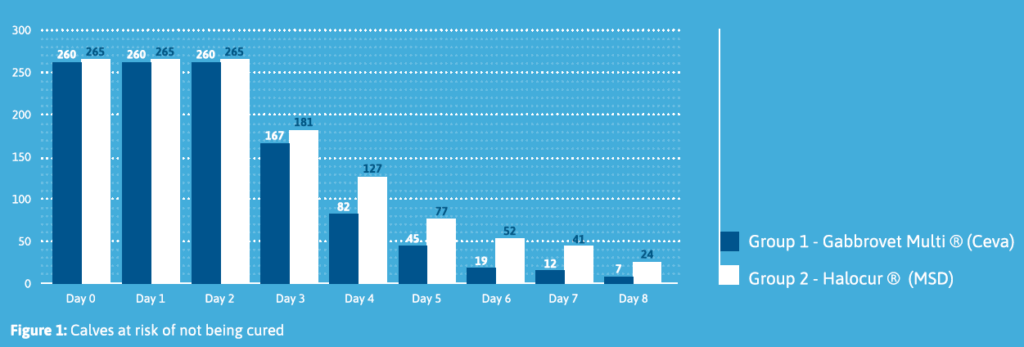Poster
Efficacy of an oral solution of paromomycin for the treatment of newborn calves with cryptosporidiosis in European farms
Authors
Damian Achard Béatrice Besche-Barbazanges Anne Trotel Gaëlle Pagny Emmanuelle Carrié Charlotte Billy Dejan Cvejic
Publication information
European Buiatrics Congress 2025
Objectives
Cryptosporidiosis is a frequent parasitological infection of mammals including calves. The ob- jective of this work is to provide insights from two large field studies conducted in Europe about the efficacy and safety of paromomycin used orally at a dosage of 150 mg/kg BW per day for 5 consecutive days against cryptosporidiosis (C. parvum) in naturally infected pre-ruminant calves.
Materials and Methods
Two independent multicenter European field studies involving 44 dairy and suckling beef farms were carried out following a parallel, controlled, randomized, blinded design. Farms were selected based on recent history of C. parvum infection in calves, absence of concomitant preventive treatments against cryptosporidiosis, absence of recent or current BVD infections, and no re- cent history of diarrhoea due to coronavirus, E. coli and rotavirus, or alternatively dedicated vaccination. To be enrolled, newborn calves were required to meet the following criteria: age between 3-14 days on first treatment, faecal score ≥ 2 (loose to watery), negative rapid test for E. coli, coronavirus, rotavirus, and positive rapid test for C. parvum. Any calf that presented with diarrhoea for > 24 hours or that has been previously exposed to antibiotics, parasiticides or probiotics was excluded. Animals were randomly allocated to two treatment groups. Calves in group 1 received 150 mg paromomycin sulfate/kg b.w. [Gabbrovet Multi®, Ceva], once daily, for 5 days by oral route while calves in group 2 were orally administered 100 µg halofuginone/kg b.w. [Halocur®, MSD], once daily, for 7 days. Several clinical and parasitological parameters were monitored at fixed times during the 21 days of the study: faecal score (0-3), general health observation (0-3), hydration score (0-3), and oocyst counts (number of oocysts per gram of dry faeces). Percentages of calves clinically cured on day 8 was considered a pivotal outcome to evaluate the efficacy of the interventions. Calves were considered cured if for a minimum of two consecutive observations all their clinical scores were equal to zero, to the exception of faecal score that could be equal to zero or 1. Other criteria such as time to clinical cure, number of days when calves were asymptomatic or considered in relapse from Day 0 to Day 8 and the parasitological cure at day 7 (oocyst count = 0) were also assessed. Safety (adverse events, serious adverse events) was evaluated at any time during the studies. The statistical unit was the calf.
Results
Five hundred twenty-five calves, with a mean age of 9 days and a mean body weight of 44 kg were enrolled. Sixty percent were from Holstein-Friesians breed, with remaining calves from various beef or crossbred breeds (Aubrac, Blonde, Limousin, Charolais, Fleckvieh). Sixty-nine percent of calves were female. 260 calves were allocated to treatment group 1, 265 to the treatment group 2. At inclusion, the treatment groups were found comparable for clinical parameters and oocysts count. 93.4% (242/260) of calves in group 1 and 80.6% (212/265) in group 2 were considered clinically cured by day 8. Clinical cure rate in group 1 was found superior to those observed in group 2 (p<0.0001). In addition, calves in group 1 were found to be cured faster in comparison to calves in group 2.

Hazard ratio (group 1 vs. group 2) was 1.40, indicating a higher likelihood (+40%) of being cured in group 1 at any time (best model). Relapses from day 2 to day 8 were low in calves from group 1 and 2 (2.7 and 2.9% respectively). The parasitological cure on day 7 was similar between the 2 groups, with a value of 77.4% in group 1 and 78.8% in group 2. The oocyst count decreased steadily after treatment in calves of group 1 from an initial mean log of 11.8 to a mean log of 2.9 on day 7. At least one adverse event was reported in 9.6 and 13.6% of calves in group 1 and 2 respectively. While none of these adverse events were considered possibly related to paromomycin, it was possibly related to halofuginone in two calves.
Conclusions
In these European field studies, daily oral treatment with 150 mg/kg of paromomycin (Gabbrovet Multi®) for 5 days was found safe and highly effective to cure sick dairy and beef calves with cryptosporidiosis and to control their oocyst burden. In addition, this treatment regimen was found superior to treatment based on halofuginone.
Publication file:




